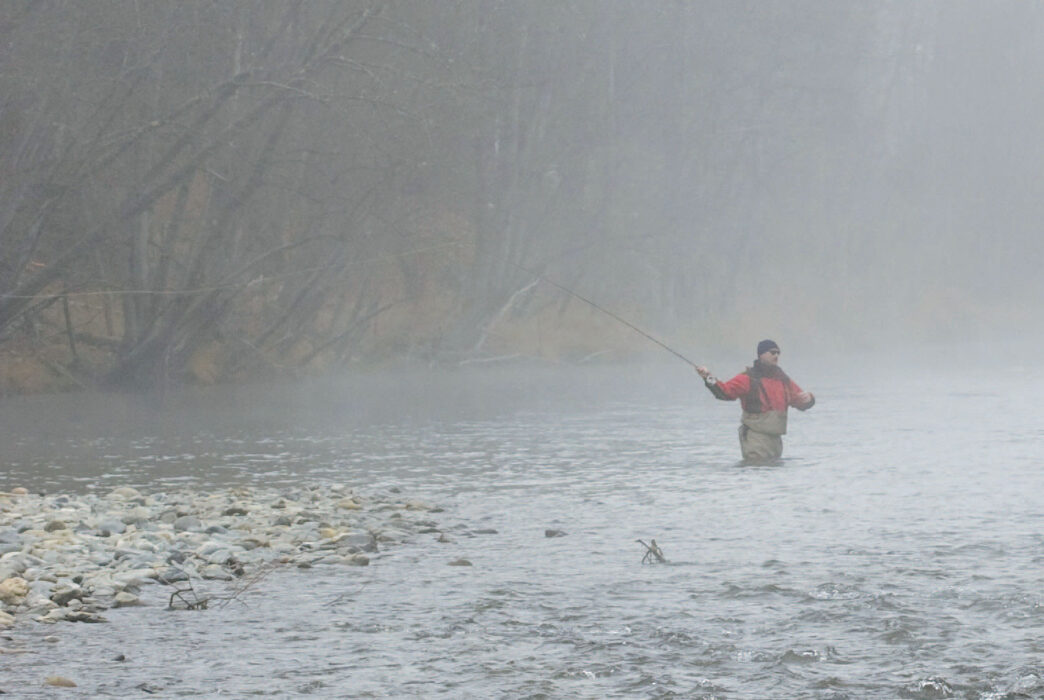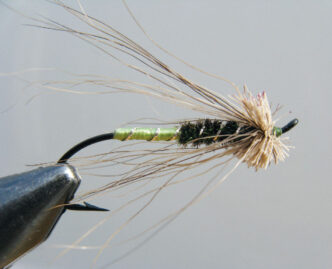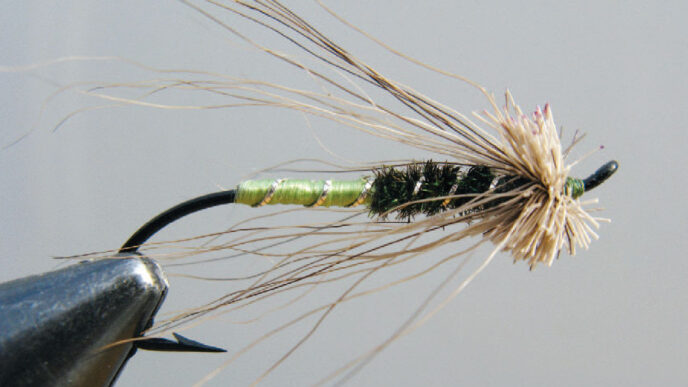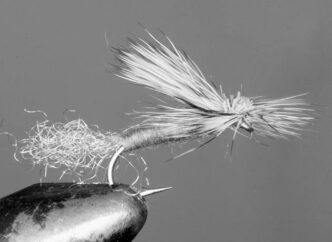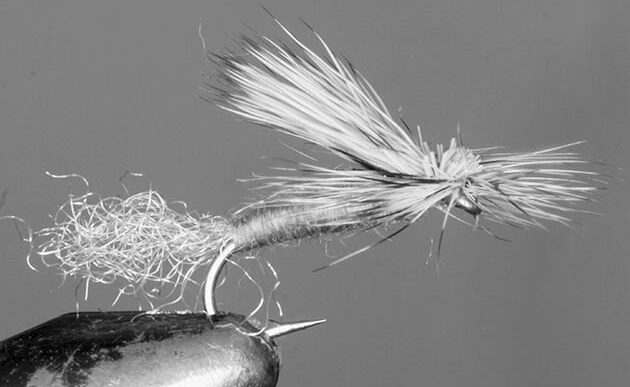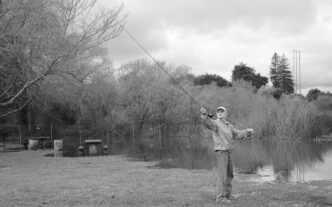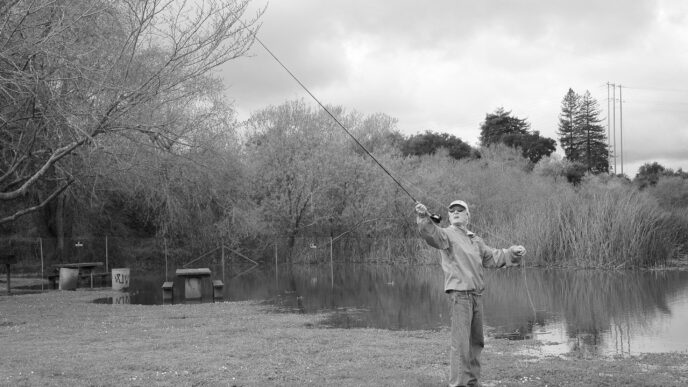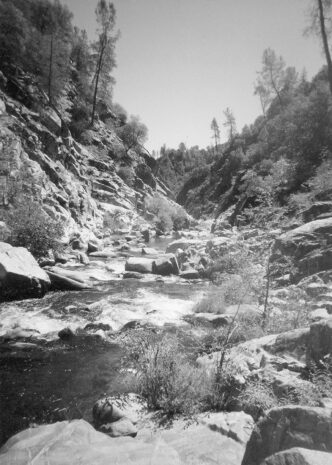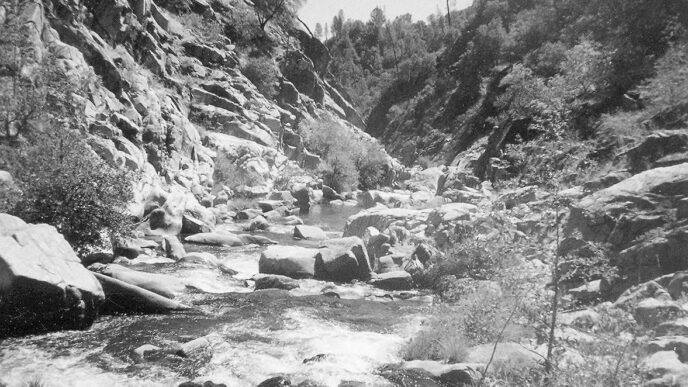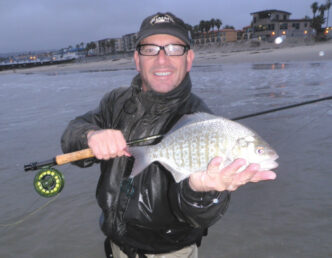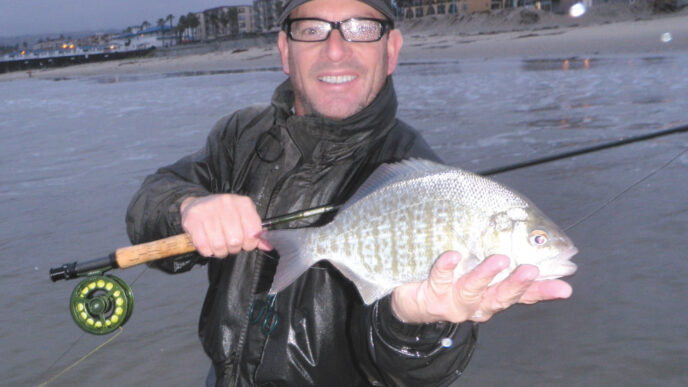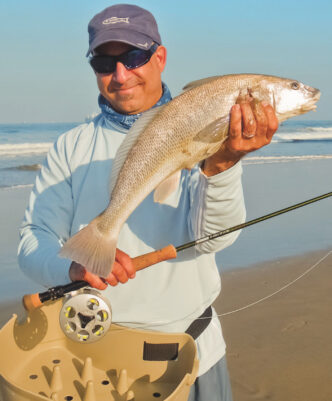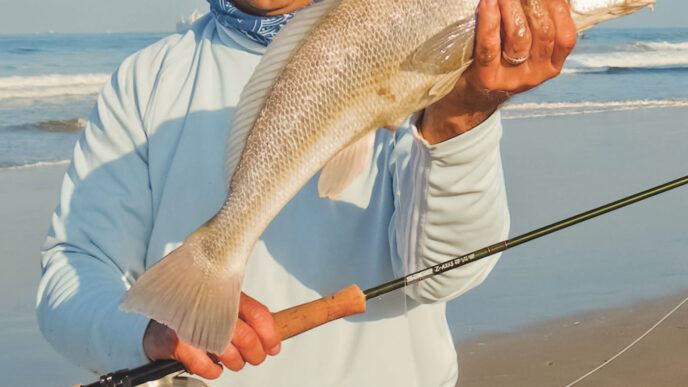I am not a believer in silver bullets when it comes to fly patterns. I currently spend about 250 days a year on the water, yet seldom have I found a particular fly pattern to be the sure-bet solution to a fishing problem. Still, some flies work better than others, and perhaps 90 percent of the fish I catch in a typical season come on a dozen essential patterns. The flies I most often use and the recipes that I offer here are not so much patterns per se, but versatile pattern types that can be fished with a variety of methods, both conventional and unconventional, to meet angling conditions and adapt to fish behavior.
In California, we fish in the winter because we can. Winter conditions, however, often make it difficult to find rivers in prime, fishable shape. Storms come and go, bringing increased flows, discolored water, and muddy or snowbound access. When the opportunity arises, often the window stays open for only a short period, so it is best to be prepared. Days are short and hatches are often compressed, which means winter is not the time to empty you fly box while experimenting with patterns. Having reliable flies and, more importantly, knowing how to present them in challenging conditions, is often the difference between a winter of cold discontent and success.
The PT — Pheasant Tail Nymph
The Pheasant Tail Nymph is a staple in my box year-round. Frank Sawyer’s nymph pattern, originated for chalk streams in England, is incredibly versatile and has stood the test of time. The pattern has been modernized by recent anglers with variations that might include peacock herl, bead heads, curved hook shanks, a variety of modern dubbings, colored wire, and flash materials. That’s why I regard it as a style of fly, not a specific pattern.
I have found most anglers on this part of the planet carry Pheasant Tails for trout streams in a beadhead flashback version in sizes 14 and 16, along with a few who pack a size 18, as well. On occasion, I find a seasoned angler with a few classic nonbeaded, nonflash patterns in his box.
These flies all appear in my winter box, but so does a local favorite tied by Bob Grace at the Ted Fay Fly Shop in Dunsmuir — Bob’s Soft-Hackle PTs in size 14 and 16. I don’t leave home without them, particularly in the winter.
The Pheasant Tail Nymph in all of its incarnations is a reasonably good imitation for nymphs of the Blue-Winged Olive, one of the most prevalent winter hatches on many California streams. It is most commonly dead drifted, either under an indicator or without one. A minor variation of this technique that increases success measurably is the Leisenring Lift, named after its originator in the 1940s, Jim Leisenring. At the end of the drift, hold the rod tip still and allow the fly to lift up with tension off the bottom. In underwater observations, Gary LaFontaine concluded that this lifting action can be so enticing to a feeding trout that the pattern doesn’t matter. Adding tiny strips at the end of the lift and beginning of the retrieve, which mimic the behavior of the emerging insect, can also bring another fish or two to net during the day. A word of warning, however:
Care must be taken to not set the hook abruptly, because the line is already tight, and too strong a hook set is likely to break the fish off.
While the PT is a nymphing staple for trout on our local year-round trout streams, I have found it equally effective for steelhead, particularly when the water is low and clear. For steelhead, it is best tied with heavy-gauge hooks. On a number of occasions the PT has been my go-to fly on the Trinity in the cold, slow, slack water where winter steelhead can be found. The big browns on the Trinity are fond of PTs, as well.
A technique for fishing the PT Nymph for steelhead in the winter that is often overlooked is the classic swing. While some fly fishers swing leeches, Spey flies, and large streamers for steelhead with conviction, I have seen precious few swinging small nymphs. Particularly during midday, when the Blue-Winged Olives are hatching and especially if a few fish heads are showing, swinging a small wet fly can be surprisingly effective.
Bob Grace’s Soft-Hackle PT attached to a long leader and a floating line and swung greased-line style can be productive, as well. As “Jock Scott” put it in the classic Greased Line Fishing for Salmon, based on the papers of A. H. E. Wood, “The basic idea is to use the line as a float for, and controlling agent of, the fly; to suspend the fly just beneath the surface of the water, and to control its path in such a way that it swims diagonally down and across the stream, entirely free from the slightest pull on the line.” Fishing a greased-line swing involves letting some slack slip through your stripping hand while keeping a slight bit of tension on the line as the fly swings into and across a feeding lane or holding lie. The grab is most often visible and can be wrenching, so take care to tie solid knots.
I recall a magical winter day recently on the Holy Water of the Rogue with rod builder Bob Meiser and Ashland Fly Shop owner Will Johnson when I shared Bob’s Soft-Hackle PT and we swung up some fine fish with light Spey rods. Will ran my fly box empty, coming back for flies again and again as sizable fish headed off with his offerings on a day when the rest of the river was high, muddy, and unfishable. I’ve enjoyed similar success with this technique on the upper and lower Sacramento, Klamath, Trinity, and Feather Rivers, along with a few small streams that will remain unnamed.
While greased-line fishing can be a joy, my favorite winter technique is fishing a hopper, copper, and dropper combination. This rig allows presentations in low, clear water to fish that have become increasingly frightened by anglers with bobbers. The big dry (hopper) I use is actually an October Caddis, while I use the Copper John as a weight to deliver the SoftHackle PT to wary trout. I tie the October Caddis to a 4X tapered leader 6 or 7 feet long, with the Copper John 2 feet or so off the bend of the hook, then attach a SoftHackle PT a foot off the bend of the Copper John for a total leader length of 9 or 10 feet. At midday, when Olives are hatching and the fishing is best, this rig has been as effective as nymphing with split shot. Trout also seem willing to take the big dry much more often than seems reasonable.
When the hatch is strong and individual risers can be targeted, I lengthen the leader, cut off the droppers, attach the Soft-Hackle PT on a foot or foot and a half of 5X or 6X tippet, and fish it in the film as an emerger or cripple. If the light is poor, I can see the take by using the October Caddis dry as a strike indicator to aid my old, failing eyesight. If the light is better, I tie on a favorite Blue-Winged Olive dry with the Soft-Hackle PT dropper. This fishing can exacting, requiring long, accurate casts over thin water to wary trout, but this is also the time of year when some of the biggest fish show.
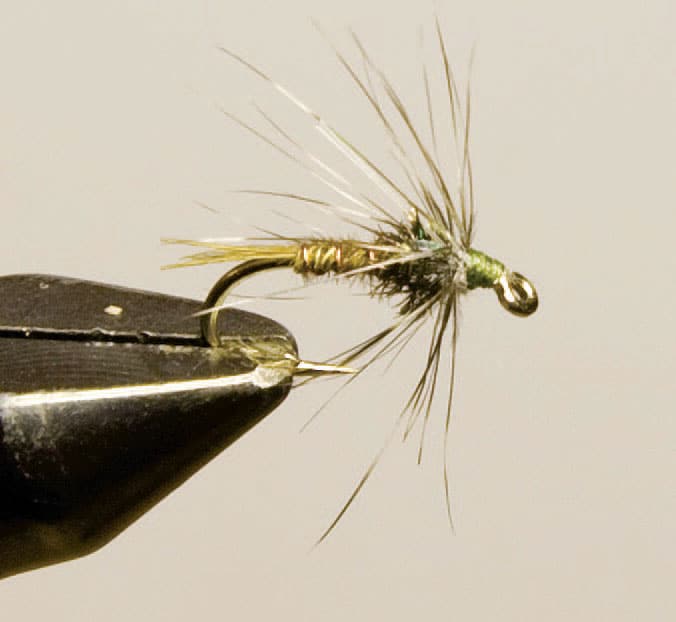
Soft-Hackle Pheasant Tail
Hook: Dai-Riki 075, size 14 through 18
Thread: Olive 8/0 Uni-Thread
Tail: Three to five olive pheasant tail fibers
Rib: Fine copper wire
Body: Three to five olive pheasant tail fibers
Wing case: Pearl Flashabou
Thorax: Peacock herl
Wing: Two or three fibers of pearl Flashabou
Hackle: Two or three turns of grizzly or blue dun hen hackle
The Copper John
From what many fly-fishing retailers tell me, the Copper John is one of the most popular trout flies in America. I believe that those who fish the Copper John with success do so not because it is an accurate imitation of aquatic invertebrates, but rather because it sinks quickly and stays in the strike zone for a longer period of time than most of the more realistic offerings. The winter, with its limited bug activity, is a time when trout must become less selective and more opportunistic. For these reasons, the Copper John has found a place in my box and on my nymphing rigs in the winter, including in my hopper, copper, and dropper rig, where it serves primarily as the sinker for my “business” point fly.
I must admit that I don’t fish the Copper John much during the regular season, but when nymphing for trout, I most often fish Copper Johns in sizes 14 and 16 as the fly closest to the split shot, with my point fly tied off the bend. For steelhead, particularly in very cold, clear water, I fish the same rig, but more often fish the Copper John as the point fly, hanging it off the bend of a Rubber Legs or egg pattern. Again, for steelhead, you may want to consider tying it on heavy-gauge hooks.
When nymphing for steelhead, a larger version of the fly, up to a size 6 on a curved shank, can be used to good effect. I also carry a Copper John–style pattern with rubber legs that has more than once turned out to be the hot fly, particularly when steelhead turn stubborn and stale. While Copper Johns in brighter colors — red, chartreuse, gold, silver, and the standard copper color — work best for me on active fish, I more often rely on black or sometimes even blue versions to save the day when fishing conditions become the most demanding.
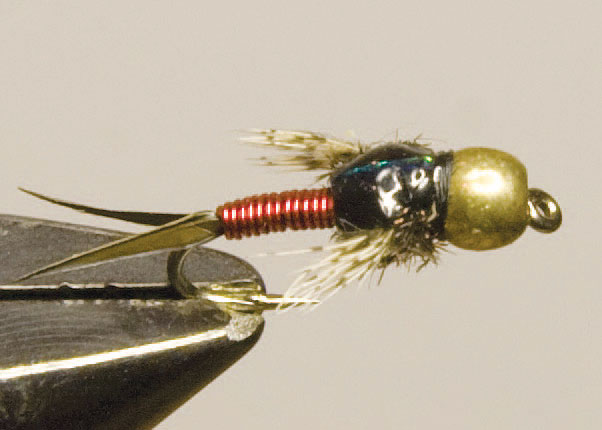
Copper John
Hook: Tiemco 3761
Bead: Gold — brass or tungsten
Thread: Black 8/0 Uni-Thread
Tail: Two black goose biots
Body: Ultra Wire — your choice of color
Wing case: Pearl Flashabou and epoxy
Thorax: Peacock herl
Legs: Partridge
Rubber Legs
Even more so than the Pheasant Tail Nymph, I consider the Rubber Legs to be a style of fly, rather than a specific pattern. Most rivers in Northern California have significant populations of Salmon Flies and Golden Stones that have multiyear maturation cycles, making the nymphs that these flies imitate available year-round.
My fly box in the winter contains anywhere from half a dozen to a dozen different versions of this fly in sizes 4 through 10. Some have legs made from rubber, others have legs made from Super Floss. Colors for the legs include black, brown, olive, white, and Golden Stone. My favorite body colors are black, brown, Golden Stone, copper/gold, and black sparkle. I have tested other, more exotic colors with limited success. However, for steelhead, I carry fluorescent orange beadhead versions I call “Hot Heads” that have been particularly effective for larger fish.
Most often, I dead drift these patterns on a nymphing rig in deeper runs and slots where trout and steelhead are known to hold. The strategy is to make the fish’s decision an easy one — stick a big fly with movement right in its face. For this reason, I most often fish a large, weighted Rubber Legs with a nymph or egg pattern tied on the bend as a dropper.
I am searching for fish that are hanging deep in the water column, so I am looking for the fly to be ticking the bottom, but not sticking to it. Adjust the distance from the indicator or add or subtract split shot to achieve the most effective drift. The more intimate I have become with the runs where fish are holding, the more success I have found with this technique and this fly.
I know a few folks who use a Rubber Legs pattern as their principal fly when swinging for steelhead on both single-handed and two-handed rods. I have been schooled by a couple of them on the Dean River in British Columbia, as well as closer to home on the Rogue, Smith, Klamath, and Trinity Rivers. Their success far outpaced that of all other anglers we encountered who were swinging flies. These guys often skip the classic, broad runs and target less pressured slots, pockets, and tailouts that other fly fishers often overlook. The key is to find fish that are on the move and aggressive, but resting in holding spots, then put a large, heavily weighted fly with movement on their noses. In clear water, these fish are sometimes visible, which can be very stimulating, provided you are able to remain composed.
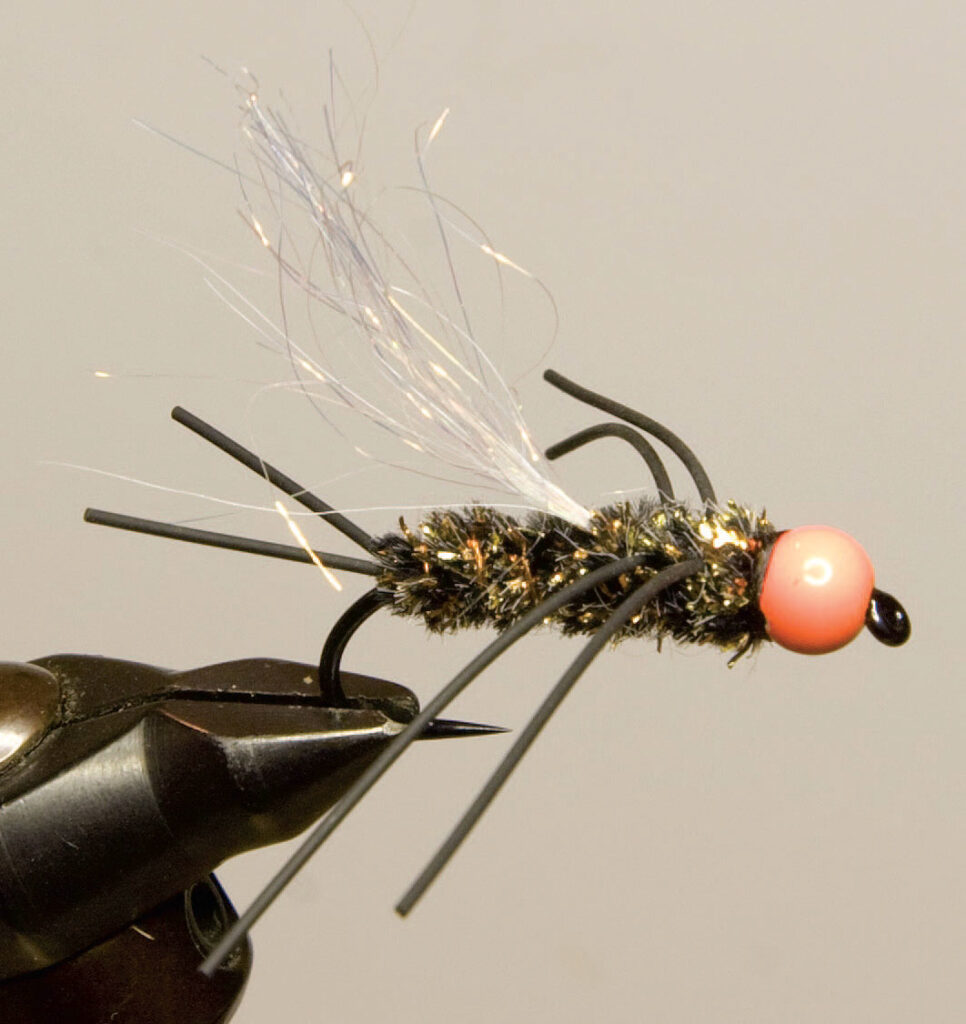
Hot Head Rubber Legs
Hook: Tiemco 700, size 4 through 8
Bead: Bright orange brass
Thread: Black 6/0 Uni-Thread
Tail: Black round rubber
Underbody: Lead-free round wire (optional)
Legs: Black round rubber
Body: Copper, gold, and black New Age Chenille
Wing: Ultrafine pearl Flashabou
Egg Patterns
Egg patterns are undeniably one of the most effective patterns for steelhead during the winter in Northern California and may account for more fish than any other imitation. While some fly fishers embrace them, others do not consider egg imitations to be flies at all and refuse to fish them. Although my personal preference is to swing flies for steelhead with two-handed rods, winter steelhead can prove stubborn when offered swung flies, particularly where I most often fish, well upstream from the coast. As a result, I have adopted a few egg patterns that, when attached to a nymphing rig, often entice a grab from a fish long after it first tasted fresh water. Classic Glo Bugs in size 8 through 12 in a variety of shades, including bright and pale orange and pink, have been a staple for as long as I can recall. I have more recently added Pettis’s Surreal Eggs, Fox Fertilizers, Micro Spawns, and weighted Thunder Eggs to the scramble.
I fish egg patterns most often in tandem with Rubber Legs or nymph patterns. When fishing them with nymphs such as Copper Johns and PTs, I attach the nymph as a dropper to the bend of the egg hook, with the egg closest to the weight, and as a result, the egg fishes tight to the bottom of the river. I often swap the placement top-to-bottom when fishing eggs with Rubber Legs, though, finding that the fish sometimes prefer one of the patterns or the other higher in the water column.
Again, the action occurs when the fly is ticking the bottom, so adjusting the weight you use, as well as the length between the fly and the an indicator (if you’re using one) can be key to finding fish, rather than spending precious winter light tying on new flies. It bears repeating that letting the flies swing up at the end of a dead drift will sometimes draw another fish or two.
Fly fishers often overlook the possibility of mending line creatively to get their flies to the depth they desire. While most anglers are accustomed to mending upstream to achieve depth and a drag-free drift, few attempt to mend downstream to lift flies through the shallower portions of a run. To achieve that, make a gentle, long, arching mend downstream from the flies, with little if any slack line.
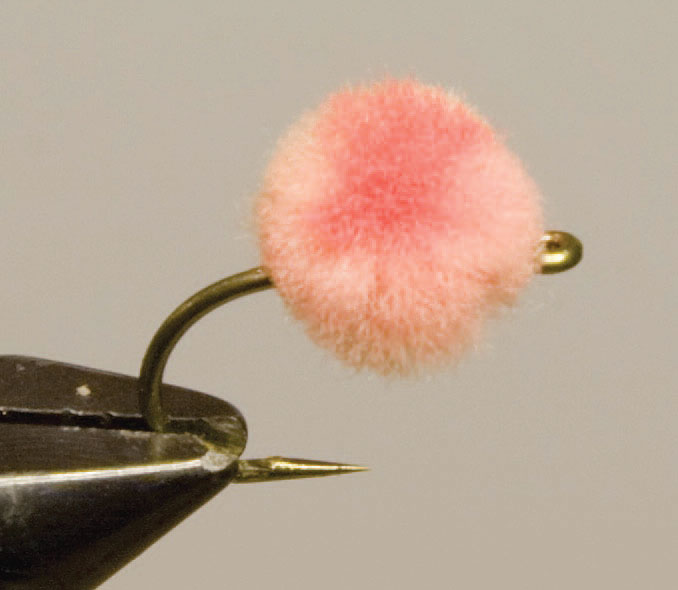
Glo Bug
Hook: Tiemco 105, size 8 through 12
Thread: Bright orange or pink Kevlar
Body: Glo Bug yarn, your choice of color
Leeches
In the winter, finding fish and getting them to grab can be a challenging affair. For years, I would tie and fish leech pat-terns that use rabbit or marabou to provide some bulk as well as movement to help beg a bite. I now typically fish large leech imitations, two and a half to four inches long, inspired by Paul Miller’s Phantom and Super Spey Leech patterns. I’ll attach to the hook’s bend a classic small wet or alevin pattern with 30 inches or more of tippet and fish the flies in tandem. I swing the flies slowly and enticingly, searching for a fish’s nose, much like teasing a cat into playing with a string.
The basic strategy is simple: The more water I cover and the more fish that see my flies, the more I am likely to find a fish willing to take. Sometimes giving a little additional motion to the fly with the line hand or rod tip can turn the trick. With leech patterns, a little retrieve before stripping in and recasting can draw strikes. There are no silver bullets in my winter fly boxes, but there are a number of fly styles and pattern variations that, when fished as conditions dictate, can help make winter fishing more enjoyable and effective. Get out there with them, and you may just find a wild winter trout or steelhead at the end of your line.
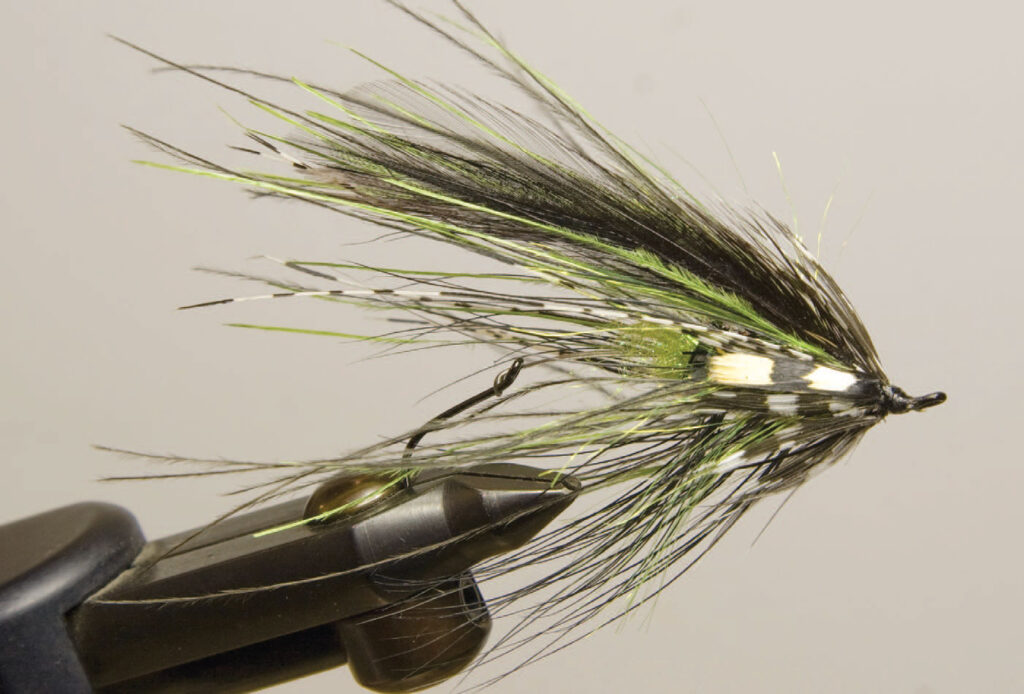
Spey Leech
Hook: Tiemco 7999 or Waddington, with size 2 or 4 Gamakatzu Octopus Stinger
Wire: 17-pound or 26-pound Surflon Micro Ultra
Thread: Black 6/0 Danville
Tag: Bright green Ice Dub or Angel Hair
Body: Peacock Lucent Chenille
Body Hackle: Black burnt Spey
Hackle: 1 dozen each black and bright green Rhea fibers, fronted by bright green Hareline Pseudo Hackle
Wing: Four matched black hackle tips
Side Accent: Four or five Lady Amherst pheasant fibers
Throat: Jumbo guinea fibers
Cheeks: Jungle cock (optional)




